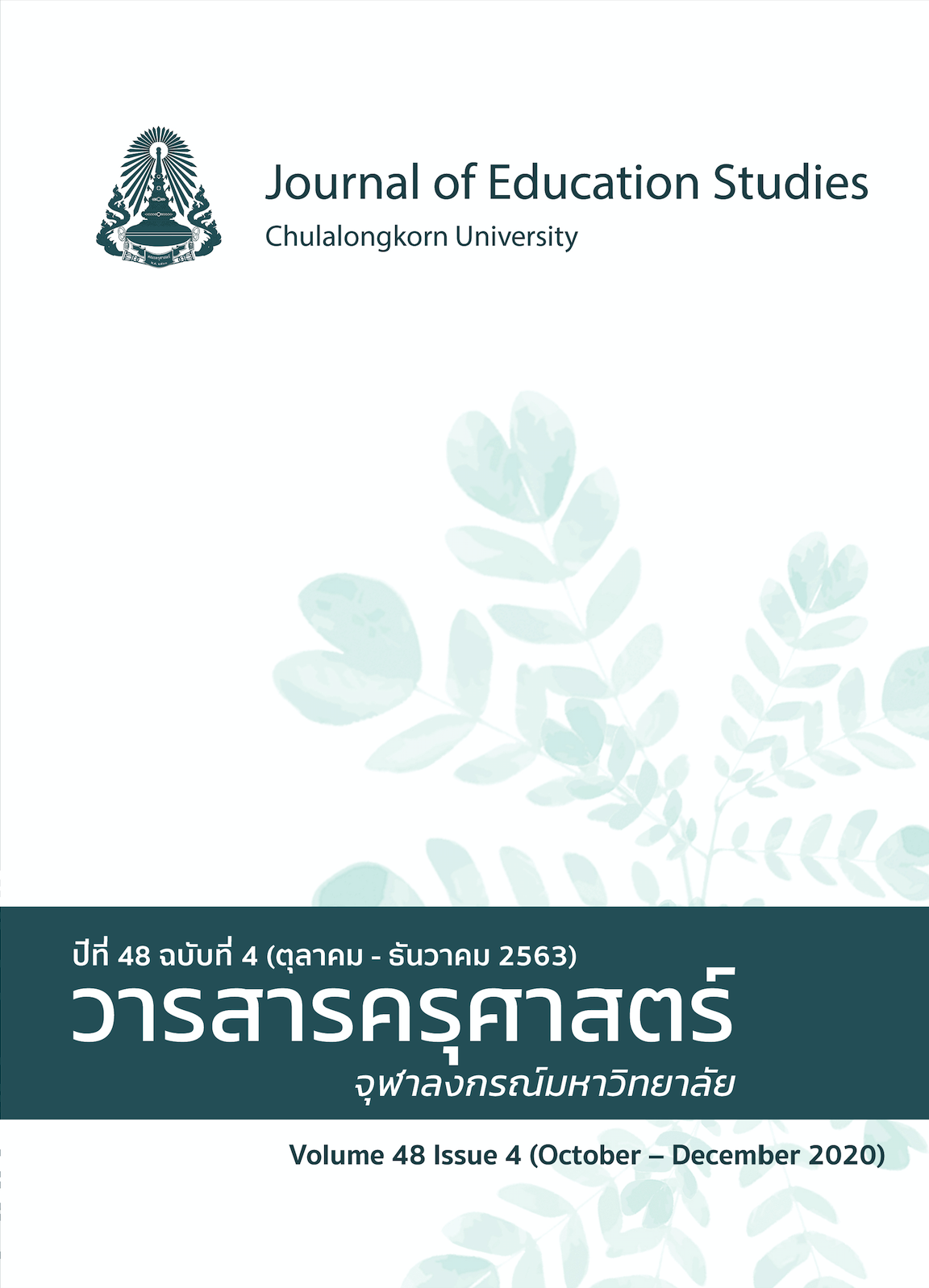Private Schools Brand Management Strategies according to the Concept of Reducing Government Budget in Education
Keywords:
strategy, brand management, government budget in education, private schoolAbstract
The purpose of this research was to: (1) study the desirable state and priority needs of private schools, and (2) develop private school brand management strategies according to the concept of reducing the government budget in education. The study sample included 272 private school administrators and teachers. A mixed method research design was employed, with the instruments including questionnaires and a strategic evaluation form. The data were analyzed using descriptive statistics (percentage, mean, standard deviation, PNIModified) and content analysis was performed based on focus group discussion. The results showed that the current state of private school brand management was mainly performed at a high level across each aspect, and the highest desirable state level was attained. The priority of needs was sorted using the PNI modified index and showed: 1) Brand Evaluation, 2) Brand Implementation, and 3) Brand Planning. According to the concept of reducing government budget in education, private school brand management strategies were comprised of 3 main strategies, 7 sub-strategies, and 24 procedures.
References
กุณฑลี รื่นรมย์. (2556). แบรนด์องค์กร การประเมินค่าแบรนด์องค์กร corporate brand success valuation. ไซเบอร์พริ้นท์.
เกริกเกียรติ พิพัฒน์เสรีธรรม. (2552). การคลังว่าด้วยการจัดสรรและการกระจาย. มหาวิทยาลัยธรรมศาสตร์.
ขวัญชนก อดทน. (2558). การสร้างแบรนด์องค์กรบนเครือข่ายสังคมออนไลน์ กรณีศึกษาหนังสือพิมพ์กรุงเทพธุรกิจ. วารสารวิชาการศรีปทุม ชลบุรี, 11(3), 118-124.
จำเนียร ชุณหโสภาค. (2559). กลยุทธ์การส่งเสริมให้มีการสร้างงานวิจัยเพื่อการนำไปใช้ประโยชน์ของมหาวิทยาลัยรามคำแหง. วารสารดุษฎีบัณฑิตทางสังคมศาสตร์, 6(1), 20-30.
ชัยมงคล สุพรมอินทร์. (2557). งบประมาณรายจ่ายภาครัฐกับการศึกษาไทย : นัยสาคัญบางประการทางการคลัง ว่าด้วยการจัดสรรงบประมาณเพื่อพัฒนาคุณภาพการศึกษาไทย. วารสารวิจัยและพัฒนา มหาวิทยาลัยราชภัฎสวนสุนันทา, 6(1), 81-99.
นริสรา พึ่งโพธิ์สภ, ฐาศุกร์ จันประเสริฐ, ดุษฎี โยเหลา, และ เชาวนี แก้วมโน. (2559). การรับรู้ภาพลักษณ์แบรนด์ การสร้างแบรนด์ภายใน และความยึดมั่นด้านความรู้สึกต่อแบรนด์องค์กรของบุคลากรในมหาวิทยาลัย. วารสารพฤติกรรมศาสตร์เพื่อการพัฒนา, 8(2), 71-92.
พฤทธิ์ ศิริบรรณพิทักษ์. (2552). การบริหารและการจัดการศึกษาเพื่อโลกใบเล็ก. พริกหวานกราฟฟิค.
วณิชชา ภัทรประสิทธิ์. (2552). การพัฒนารูปแบบการสนับสนุนสถานศึกษาเอกชนระดับการศึกษาขั้นพื้นฐาน [วิทยานิพนธ์ปริญญาดุษฎีบัณฑิต]. Chulalongkorn University Intellectual Repository (CUIR). http://cuir.car.chula.ac.th/handle/123456789/19435
ศุภเสฏฐ์ คณากุล และคณะ. (2560). ข้อเสนอแนวทางส่งเสริมการมีส่วนร่วมของเอกชนในการจัดการศึกษา. การประชุมคณะทำงานจัดทำข้อเสนอในการมีส่วนร่วมจัดการศึกษาขั้นพื้นฐานและอาชีวศึกษาของภาคเอกชน ครั้งที่ 1/2560. สำนักงานเลขาธิการสภาการศึกษา, กรุงเทพมหานคร.
สำนักงานคณะกรรมการพัฒนาการเศรษฐกิจและสังคมแห่งชาติ. (2561). งบประมาณรายจ่ายด้านการศึกษาต่อ GDP และงบประมาณด้านการศึกษาต่องบประมาณแผ่นดิน ปีงบประมาณ 2535-2560. https://www.m-society.go.th/ewtadmin/ewt/mso_web/ewt_news.php?nid=17780
สำนักงานเลขาธิการสภาการศึกษา. (2550). ยุทธศาสตร์ส่งเสริมการมีส่วนร่วมของเอกชนในการจัดการศึกษาขั้นพื้นฐาน. พริกหวานกราฟฟิก.
สำนักงานเลขาธิการสภาการศึกษา. (2551). การสังเคราะห์งานวิจัย แนวทางการส่งเสริมการมีส่วนร่วมของเอกชนในการจัดการศึกษาขั้นพื้นฐาน. กรุงเทพฯ: พริกหวานกราฟฟิก.
สำนักงานเลขาธิการสภาการศึกษา. (2553). บทบาทและผลกระทบของหุ้นส่วนการศึกษาระหว่างภาครัฐกับเอกชน. สกสค. ลาดพร้าว.
ภาษาอังกฤษ
Aaker, D. A. (2012). Building strong brands. Simon & Schuster.
Burmann, C., Jost-Benz, M., & Riley, N. (2009). Towards an identity-based brand equity model. Journal of Business Research, 62(3), 390-397. http://dx.doi.org/10.1016/j.jbusres.2008.06.009
Burmann, C., & Zeplin, S. (2005). Building brand commitment: A behavioral approach to internal brand management. Journal of Brand Management, 12, 279-300. https://doi.org/10.1057/palgrave.bm.2540223
De Chernatony, L. (2001). From brand vision to brand evaluation: Strategically building and sustaining brands. Butterworth-Heinemann.
DiMartino, C., & Jessen, S. B. (2014). School brand management: The policies, practices, and perceptions of branding and marketing in New York city’s public high schools. Urban Education, 51(5), 447-475. https://doi.org/10.1177/0042085914543112
Drummond, G. (2004). Consumer confusion: reduction strategies in higher education. International Journal of Educational Management, 18(5), 317-323.
Gustafsson, B. A., & Porsfelt, D. (2009, July 2-4). Branding public schools in Sweden on legitimacy, values & identity [Symposium]. The 25th EGOS Colloquium, Barcelona.
Hatch, M. J., & Schultz, M. (2008). Taking brand initiative: How companies can align strategy, culture, and identity through corporate branding. Wiley.
Keller, K. L. (2013). Strategic brand management: Building, measuring, and managing brand equity (4th ed.). Pearson.
Khan, B. M. (2009). Internal branding: Aligning human capital strategy with brand strategy. Journal of Brand Management, 6(2), 22-36.
Knapp, D. E. (2000). The brandmindset. McGraw-Hill.
Kotler, P., & Keller, K. L. (2012). Marketing management (14th ed.). Prentice Hall.
Kotler, P., & Murphy, P. E. (1981). Strategic planning for higher education. The Journal of Higher Education, 52(5), 470-489.
Miller, A., & Dess, G. G. (1993). Assessing Porter's (1980) model in terms of its generalizability, accuracy and simplicity. Journal of Management Studies, 30(4), 553-585.
Morgan, L. (2006). Marketing at Baylor business. Baylor Business Review, 24(2), 28.
Santos-Vijande, M. L., del Río-Lanza, A. B., Suárez-Álvarez, L., & Díaz-Martín, A. M. (2013). The brand management system and service firm competitiveness. Journal of Business Research, 66(2), 148-157. http://dx.doi.org/10.1016/j.jbusres.2012.07.007
Vallaster, C., & De Chernatony, L. (2005). Internationalisation of services brands: The role of leadership during the internal brand building process. Journal of Marketing Management, 21(1-2), 181-203.
Veladat, F., Yazdani, F., & Navehebrahim, A. (2011). School brands engaged in cost-benefit analysis: Schooling market. Procedia-Social and Behavioral Sciences, 29, 1342-1348. http://dx.doi.org/10.1016/j.sbspro.2011.11.372
Yamane, T. (1973). Statistics: An introductory analysis. Harper & Row.




